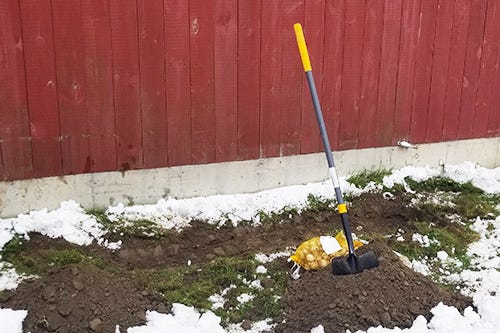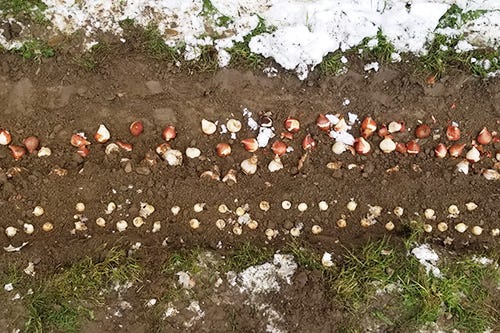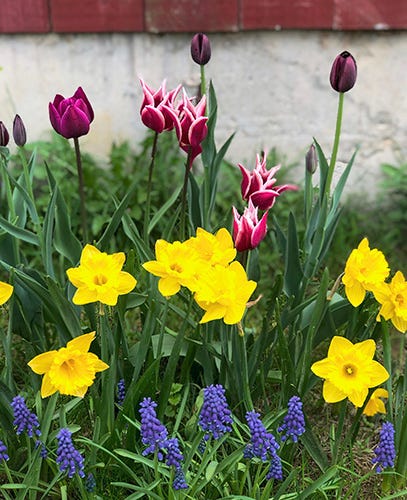Trench planting is a quick, efficient way to plant flower bulbs for hundreds of spring blooms with minimal effort. If you’ve ever visited a botanic garden in early spring, you’re sure to have seen brilliant swaths of blooming Tulips, Daffodils and Hyacinth. You don’t need a horticultural staff to get this look in your own yard! By trench planting bulbs in fall, you can easily get 100 bulbs planted in under an hour. With just a little time and planning, you’ll have a wonderful spring gift awaiting you.
Trench Planting Bulbs In 6 Simple Steps
- Choose your bulbs. We suggest planting at least 100 blooms for a big impact. Choose your favorite variety, or go with a bulb collection to make design simple.
- Dig a trench to the right depth for the flower bulb you’ve chosen, plus 2-4 inches to loosen the soil below the bubs. Most bulbs need to be planted between 4-8” deep, and you will find that information on the pacakge.
- Place the bulbs in the trench, pointy side up. When planting a collection or a variety of bulbs, you have a few options for design. You can mix up your bulbs to plant them in a natural style, or you can plant them in rows or blocks of color. When planting in rows, you may want to put shorter flowers in front and taller flowers in back.
- Cover with soil and press firmly with your hands. If bulbs need to be planted at different depths, you can plant in layers.
- Water thoroughly to elimiate of any air pockets.
- Come spring, you’ll be greeted with bright cheery blooms!


Helpful Trench Planting Hints
- If your soil is hard to dig, you can also create a raised bed for bulbs.
- If you have concerns about rodents eating or damaging your bulbs underground over the winter, try adding a layer of gravel below and around your bulbs. It will deter burrowing critters from reaching the bulbs. You can also use bulb cages, or opt for critter-resistant bulb varieties such as Daffodils, Alliums, Squill, and Hyacinth.
- If you have concerns about deer or rabbits, be sure to use a deer repellent in spring.
- You can make a big impact in a small area. A 1 ft. x 5 ft. planting area can be dug quickly, usually in 10 to 15 minutes, but is large enough to give you a beautiful swath of bright blooms in spring.
10 Tips For Gardening With Fall-Planted Bulbs
1. Plant bulbs in layers for a “bursting with blooms” look
You can mix bulbs that require different depths. Plant those that need the greatest depth first. Add a few inches of soil and plant the next layer of bulbs that need shallower planting, and so on.
- Learn more in our guide to layering: Lasagna Planting Bulbs For Spring Blooms
2. Mix bulbs with perennials
You can also plant perennials on top of the bulbs, to disguise the bulb foliage as it dies back. Spring-blooming groundcovers such as Phlox, Veronica, and Thyme work particularly well, as they will bloom in tandem with the bulbs.
- Learn more about pairing perennials: Colorful Combinations - Mixing Perennials and Spring Blooming Bulbs
3. Plant for non-stop blooms
You can easily extend your garden's bloom season by choosing a variety of bulbs. Make sure you have early-spring, mid-spring, late-spring blooms in the mix, and you'll never have a gap in your flowers.
- Early Spring-Blooming Bulbs include Crocus, Mini Iris, and Wildflower Tulips. Crocus, Spring Starflowers, and Snowdrops pop through the snow in early spring.
- Mid-To-Late Spring Blooming Bulbs include Grape Hyacinth (Muscari), Hyacinth, Darwin Tulips, and Daffodils.
- Late Spring to Early Summer Blooms include Alliums and Fritillaria.
4. Plant bulbs where you can appreciate them
- If you’re using small bulbs, be sure to place them near a walkway so that you can appreciate their delicate blooms.
- Plant bulbs in containers to spruce up your patio or porch.
- Consider planting a garden in a space where you often look out the window.
- Use larger, bolder-blooming bulbs in large groupings if the planting will be viewed from a distance.
5. Make sure you have enough bulbs
Plant bulbs at the right density for the best impact. You can fit quite a few bulbs in small spaces, so be sure to order enough to fill in your planting area with plenty of flowers. You'll find recommended bulb spacing on each product page, as well as on the bulb packaging.
- Smaller bulbs, such as Crocus, Grape Hyacinth (Muscari), and small blooming Allium, are around 16 bulbs per square foot.
- For larger bulbs, such as Tulips, Daffodils, and Hyacinth, typically 6 bulbs are planted per square foot.
- Some large bulbs, such as Globe Master Allium and Crown Imperial (Fritillaria), are planted with as few as 3 bubs per square foot.
6. Simplify Planting With Similar Bulb Size
For simple planting, choose bulbs that require the same planting density and planting depth. One easy way to do that is to plant a mix of the same bulb variety. For example, mini bulbs including Crocus, mini Daffodils, Grape Hyacinth (Muscari), and Mini Iris pair well, as most are planted with 16 bulbs per square foot and 2-4” inches deep.
7. Plant Once, Enjoy For Years To Come
Choose spring-blooming bulbs that naturalize - it means they are perennial bulbs that will multiply and spread. You’ll plant these bulbs just once, and enjoy them more year after year. Good naturalizers include Daffodils, Glory of the Snow (Chionodoxa), Grape Hyacinth (Muscari), and Wildflower Tulips. To ensure reblooming, fertilize after blooming each year with a 3-5-3 fertilizer.
8. Keep Your Garden Off The Menu
If you have pressure from hungry deer or other pests such as squirrels and voles, choose critter-resistant bulb varieties such as Daffodils, Grape Hyacinth (Muscari), Fritillaria, and Hyacinth. Planting strong-smelling Fritillaria amongst Tulips will often deter pests from Tulip bulbs, which are not pest resistant. (Note: Wildflower Tulips are deer resistant!)
9. Make A Statement With Monochromatic Blooms
Your planting will truly be eye-catching if you stick to one color. You can accomplish this in several ways.
- One variety, different bloom times: For example, try planting all Daffodils, but choose varieties with early, mid, and late spring bloom times.
- Many varieties, one color: For example, create a pleasing purple palette with Crocus and Mini Iris for early blooms, Tulips, Grape Hyacinth, and Hyacinth for mid-season blooms, and Allium for late-season flowers.
10. Fall In Love With Your Lawn
You can really create a spring show by planting large swaths of color in your lawn! Flowers will poke through the lawn and bloom in spring, well before the grass wakes up from dormancy and grows tall enough to mow.
- Follow trench planting steps above - but remove sod before trench planting. Make sure to account for the depth of the sod, and add a couple of inches when digging your trench.
- After bulbs are planted, lay the sod over the planted area. Then, in spring, enjoy the show!
- After your bulbs have gone dormant (a few weeks after blooming), you can resume mowing the area.
- Crocus, Daffodils, and Wildflower Tulips are popular choices for naturalizing in the lawn!

